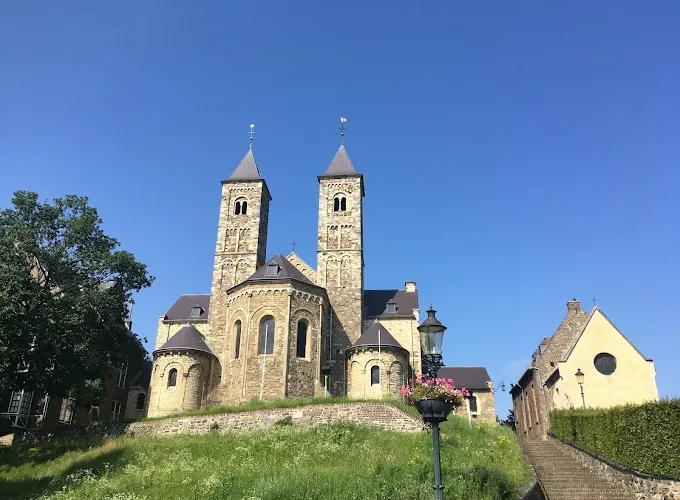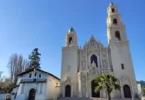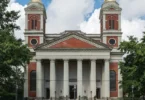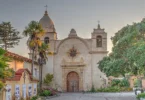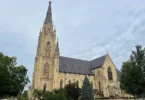Introduction
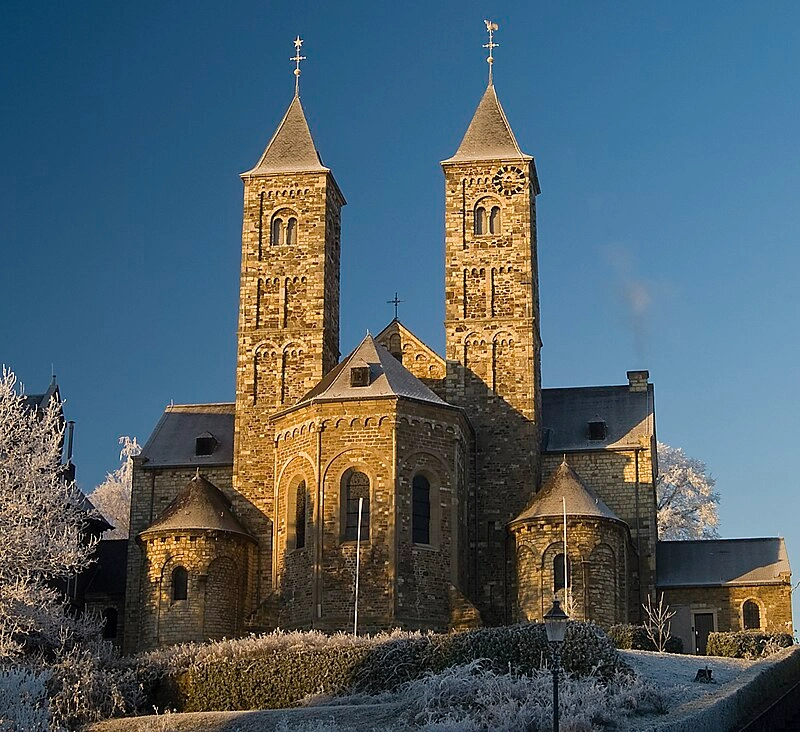
The Basilica of Saints Wiro, Plechelmus, and Otgerus, located in the village of Sint Odiliënberg in the Dutch province of Limburg, is a historic Roman Catholic parish church within the Diocese of Roermond. This sacred site, prominently situated atop a church hill overlooking the Roer River, has long been a center of religious and architectural significance. Originally established in the early medieval period, the church honors three missionary saints who played vital roles in the Christianization of the region.
In recognition of its spiritual and cultural importance, the church was elevated to the status of a minor basilica by Pope Pius XII in 1957. Architecturally, the basilica is a fine example of Romanesque style, though it has undergone significant restorations throughout its history. The first major reconstruction took place between 1880 and 1883, while a second, extensive rebuilding was necessary between 1945 and 1951 due to damage sustained during World War II. Today, the Basilica of Saints Wiro, Plechelmus, and Otgerus stands as both a monument of faith and a testament to the enduring legacy of Romanesque architecture in the Netherlands.
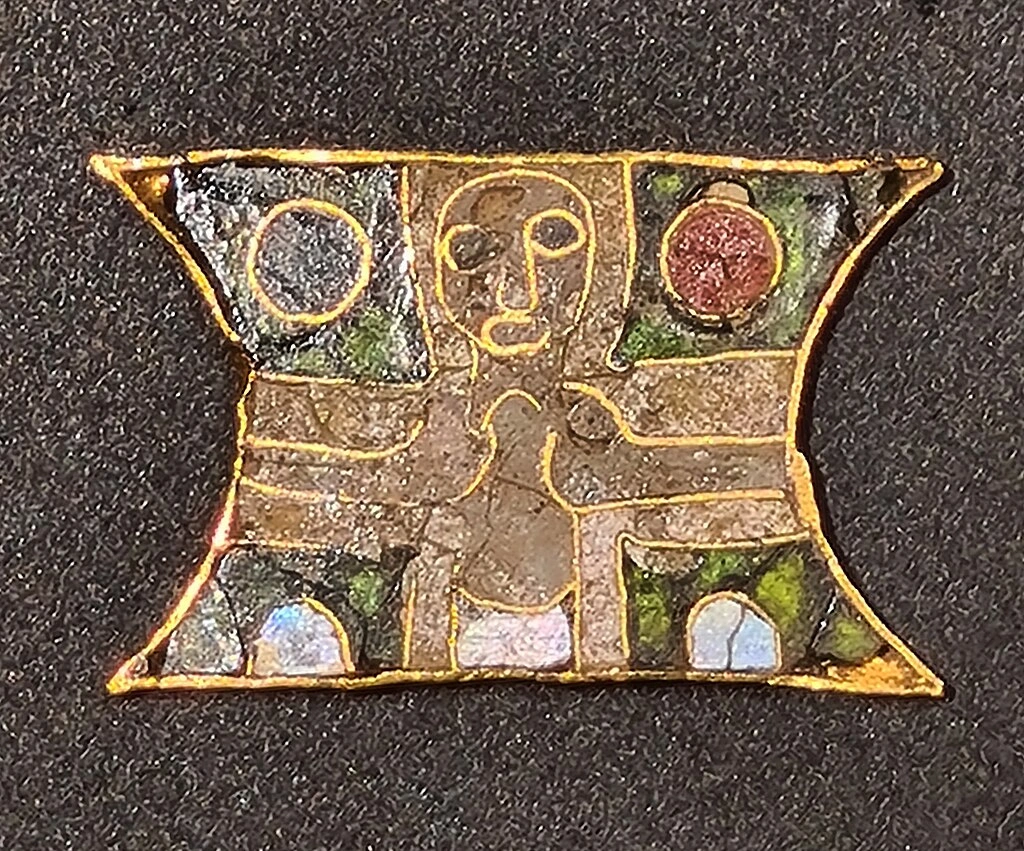
The Basilica of the HH Wiro, Plechelmus, and Otgerus, situated in Sint Odiliënberg, has a rich and layered history that spans over a millennium. The church’s origins trace back to the early 7th century, when three monks from the British Isles—Saint Wiro, Saint Plechelmus, and Saint Otgerus—are said to have established a monastic community on a hill near the Roer River. This hill, later known as Sint-Petrusberg, became the site of the monastery and is where the village of Sint Odiliënberg later developed.
The Foundation of the Abbey: Around 700 AD
According to tradition, the founding of the abbey occurred around 700 AD. The three monks—Wiro, Plechelmus, and Otgerus—brought Christianity to this region, establishing an abbey that became a vital center for religious life and missionary work. The monastic community, situated in a strategic location on a hill, was dedicated to the Saint Peter. Over time, the area surrounding the abbey developed into the village of Sint Odiliënberg. The monastery’s importance grew over the centuries, and in 858 AD, King Lotharius II granted the mons S. Petri (Saint Peter’s hill) along with the monastery to Bishop Hungerus of Utrecht. This donation marked the beginning of the church’s significant connection to the Diocese of Utrecht, which would persist for centuries, despite the shifting political and ecclesiastical landscape of the region.
The Role of the Abbey During Viking Raids
The Viking raids of the 9th and 10th centuries had a profound impact on the region. The abbey served as a sanctuary for the clergy of Utrecht during these tumultuous times. It was during this period that the monastery became an enclave of the Diocese of Utrecht within the Diocese of Liège. This unique arrangement ensured the abbey’s survival and preservation of its spiritual and cultural role during a time of external threat.
The Elevation of the Saints’ Relics
In the 10th century, the Bishop of Utrecht undertook the elevation of the relics of Wiro, Plechelmus, and Otgerus, a practice that was the medieval equivalent of canonization. This act not only affirmed their holiness but also solidified their status as patron saints of the region. From that point forward, the three saints were venerated within the Diocese of Utrecht, and the abbey became an important pilgrimage site. Their elevation further cemented the church’s significance as a center of religious devotion.
The Church’s Transformation and Donations
In 1057, the Bishop of Liège confirmed the donation of the church of “Berg” (Sint Odiliënberg) to the Diocese of Utrecht. The continued importance of the church is evident in the historical records, as the church and its surrounding lands were frequently the subject of donations, reaffirming its central role in the religious and political life of the region. By 1226, the Bishop of Utrecht ceded his share of the church property to Count Gerard III of Gelre, a significant political move that shifted some of the authority over the region. The lords of Heinsberg had already held the guardianship of the area for several generations, and this arrangement continued even after 1226.
Secularization and Transition to a Chapter
Possibly around 1100, the monastic community underwent a significant change. The monastery was transformed into a secular chapter, marking a shift from monastic to cathedral-style governance. The secular chapter had its own leadership structure, with a provost and seven canons by 1356. By 1361, the chapter moved to the Holy Spirit Chapel in Roermond, where it continued to grow in influence, eventually boasting ten canons by 1433. In 1559, the chapter was restructured as the cathedral chapter of the Diocese of Roermond. The chapter would later transfer to St. Christopher’s Cathedral in Roermond just two years later, and the monastery buildings in Sint Odiliënberg became home to various sepulchres—tombs for prominent religious figures. At the end of the 17th century, the monastery itself was dissolved, and the monastery church was repurposed as a parish church, marking the end of its role as a monastic center.
The Church's Architecture: Early Structures and Restorations
The Original Church Structure
The original church building, constructed in the early medieval period, no longer exists above ground. Archaeological evidence suggests that the first church was a single-nave structure with a westwork (a type of monumental western facade) and a narrower choir. This early church was dedicated to Saint Peter, a fitting homage to the abbey’s original patron. By the 11th and 12th centuries, the church underwent significant reconstruction, likely replacing the early church with a more advanced structure. Archaeological investigations have revealed remnants of the early church, including stone foundations and building fragments from around 800 AD.
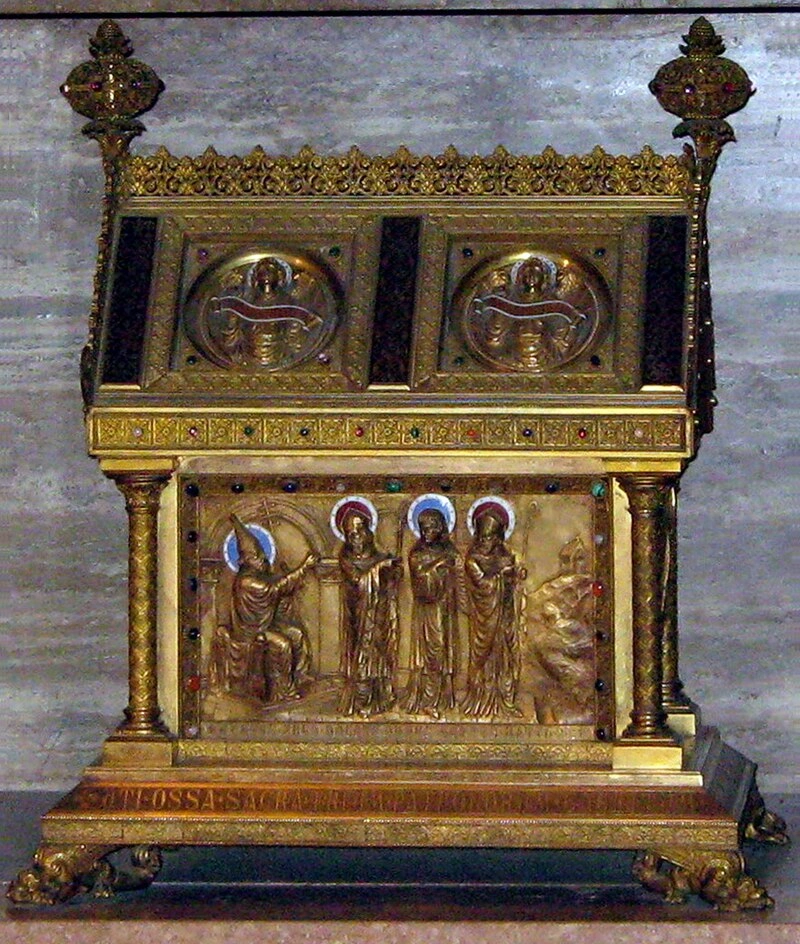
The 1360 Altar
Around 1360, a specific altar was consecrated within the church, dedicated to the three saints—Wiro, Plechelmus, and Otgerus. This altar would have become an important focus for the growing veneration of the three saints and their relics.
17th-Century Restoration
In the years 1679 to 1688, a more modest restoration of the church was carried out by Pastor Willem Basel. This restoration likely included repairs and minor adjustments to maintain the church’s function and structure.
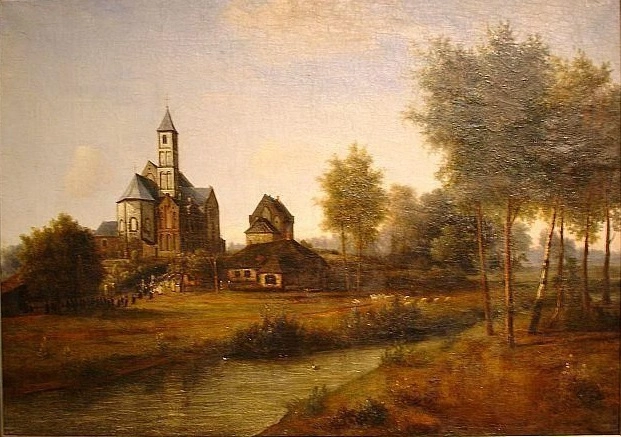
Major Restoration Projects
The 1880-1883 Restoration
The most significant and radical restoration of the church took place between 1880 and 1883 under the direction of architect Johannes Kayser, with the encouragement of Pastor Michaël Willemsen. During this restoration, substantial parts of the church were reconstructed, including the side aisles, southern transept arm, front facade, and two side choirs at the transept. The restoration sought to return the church to a form more faithful to its Romanesque origins, and existing building fragments were used to guide the restoration. During this work, a grave believed to contain the relics of the three saints was uncovered. The newly restored church was consecrated in May 1886 by Archbishop Snickers of Utrecht. This marked a new chapter in the church’s long history, and its architectural legacy was solidified.
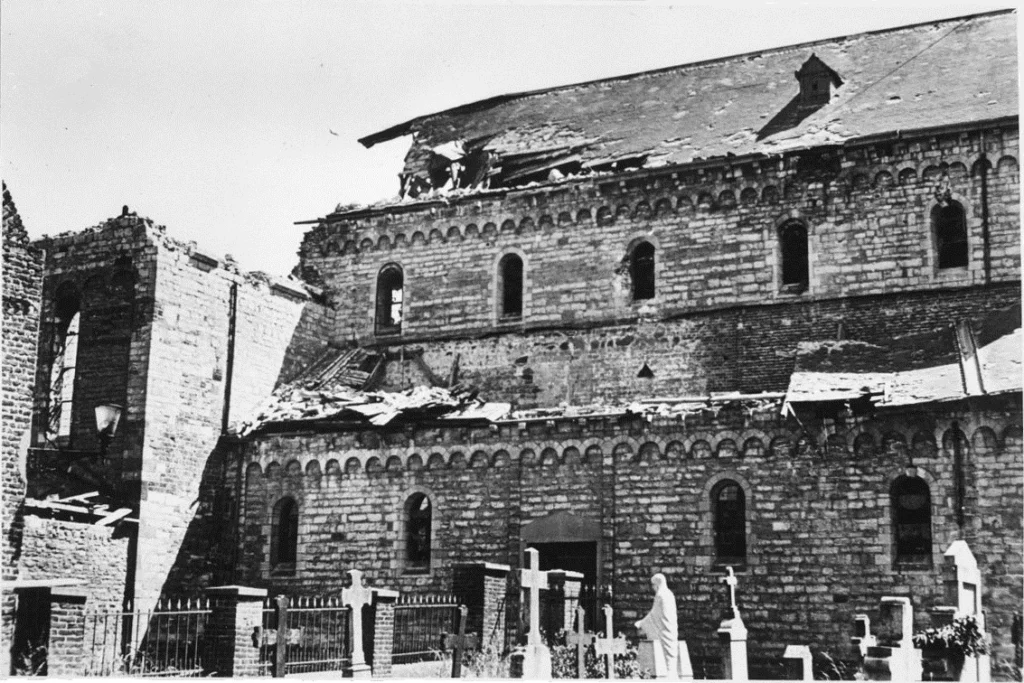
War Damage and Post-War Restoration
In early 1945, during World War II, the church was severely damaged when German forces blew up the choir towers, leading to the destruction of large parts of the choir and transept. What remained was a ruin, but efforts to rebuild the church began shortly after the war. The reconstruction took place between 1945 and 1951 under the direction of ir. J. Witteveen. While much of the exterior was restored, the interior was simplified in the post-war restoration process. During the restoration, archaeological investigations were carried out, revealing important historical findings. The investigations uncovered an older polygonal choir closure beneath the choir area, along with a red mortar floor dating to the early Middle Ages. Within this structure, a saint’s grave was discovered, which is believed to be the resting place of Wiro, Plechelmus, and Otgerus.
Stained Glass Windows and Final Touches
In 1953, Joep Nicolas, a renowned artist, was commissioned to create stained glass windows for the church. These windows were completed in 1954 and added a beautiful and colorful element to the restored church.
Elevation to Basilica Status
In 1957, the church was officially elevated to the status of basilica minor by Pope Pius XII. This prestigious title recognized the church’s significant historical, religious, and architectural value, affirming its importance as a place of pilgrimage and worship within the Catholic Church.
Architecture of Basilica of Sts. Wiro, Plechelm and Otger Sint-Odiliënberg, Netherlands
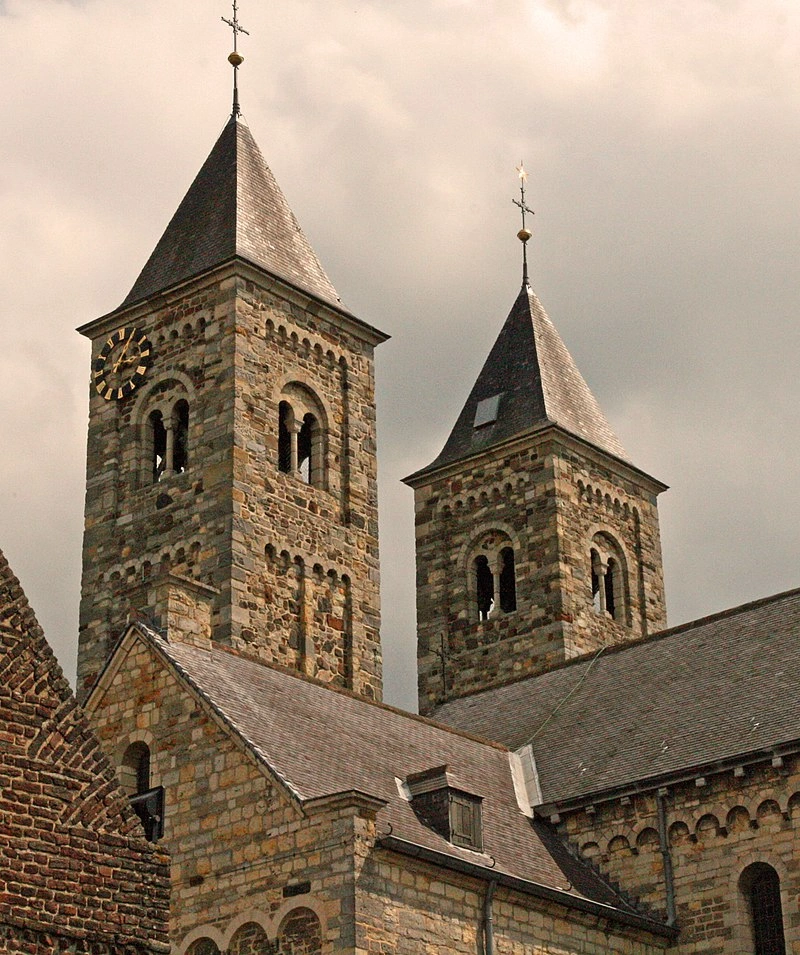
Architect : Johannes Kayser.
Architectural style : Renaissance Revival architecture, Baroque Revival architecture.
Exterior of the Basilica
The exterior of the Basilica of the HH Wiro, Plechelmus, and Otgerus is a powerful expression of Romanesque architecture, skillfully combining regional materials with stylistic elements that reflect both historical continuity and 19th-century restoration. Constructed using Kunradersteen, Maas boulders, and upper carboniferous sandstone, the church’s exterior showcases a rich palette of textures and tones, grounding the building in its natural and cultural landscape. The current structure owes much of its appearance to the influential Cuypers restoration (1880–1883), which introduced a three-aisled nave with five bays, a narrower choir, and a distinctive three-part choir closure. This eastern end is dramatically flanked by two choir towers, whose vertical massing reinforces the church’s monumental presence while maintaining the balanced proportions of Romanesque design. Adding to the architectural rhythm are the apsidioles—small apses that surround the main chancel—contributing both liturgical function and visual depth.
On the north side, the basilica is bordered by a cemetery, offering a solemn reminder of the church’s role as a place of rest and remembrance for generations of parishioners. The west façade serves as the primary entrance and a visual focal point, marked by clean Romanesque lines and a sense of understated grandeur. Whether viewed from the front, side, or in elevation, the basilica’s exterior conveys a deep sense of stability, reverence, and architectural integrity—rooted in its ancient origins and carefully preserved through modern interventions.
Interior of the Basilica
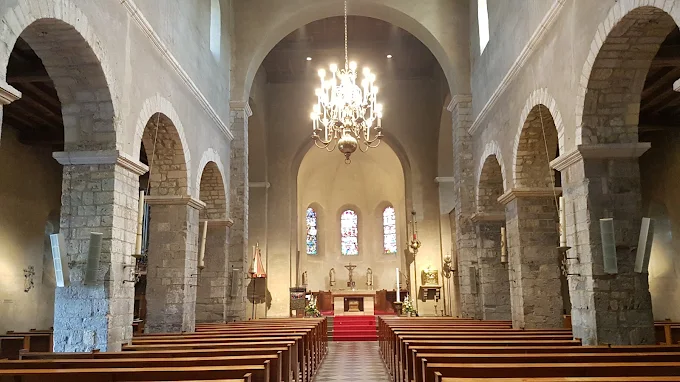
The interior of the Basilica of the HH Wiro, Plechelmus, and Otgerus is a remarkable example of Romanesque revival architecture, harmoniously combining historical depth with post-war restoration. While much of its current form was shaped during the reconstruction after 1945, the space faithfully preserves the design principles laid out by architect Pierre Cuypers during his 1880 restoration. The interior is defined by massive square pillars that support a rhythmic series of round Romanesque arches, creating a sense of solemnity, stability, and vertical aspiration. These architectural elements guide the visitor’s gaze toward the choir, enhancing the church’s spiritual atmosphere. The walls are mostly plastered, but the exposed stonework of the pillars and inner arches reveals the original textures of the structure, preserving the material authenticity of the medieval church. The ceiling is flat and constructed from wood, adding warmth and simplicity that complement the otherwise monumental character of the space. A significant artistic and musical feature is the baroque pipe organ, positioned prominently within the nave. Its ornate design and rich tonal qualities contribute to the sacred atmosphere and underscore the church’s role as both a liturgical and cultural venue. Key views within the church—such as those toward the choir, from the side aisles, or across the reconstructed northwestern section—highlight the balanced proportions and spatial harmony that define this sacred space. The interior stands as a thoughtful dialogue between past and present, uniting historical reverence with architectural clarity.
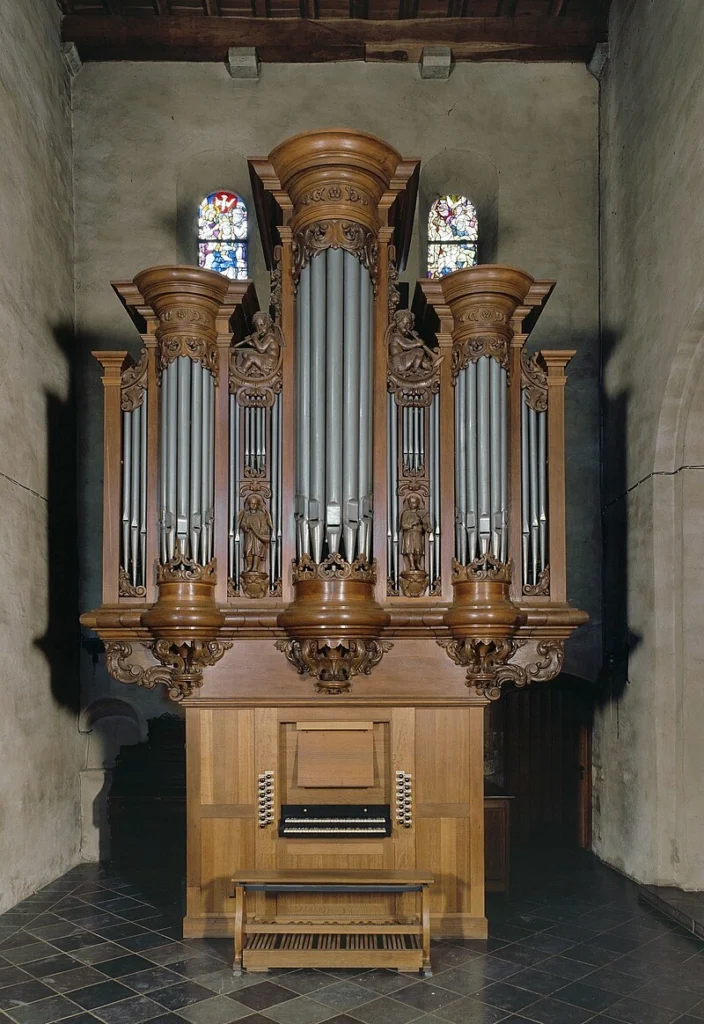
Relics and Works of Art
The Basilica of the HH Wiro, Plechelmus, and Otgerus houses a remarkable collection of religious artifacts and relics that reflect its long and sacred history. Among the most prized objects is the 12th-century statue of the Sedes Sapientiae, or “Seat of Wisdom,” which is currently preserved in the nearby Chapel of Our Lady. This medieval sculpture of the Virgin Mary holding the Christ Child is a rare and beautifully crafted example of Romanesque devotional art, embodying both theological symbolism and artistic refinement. Another important artifact within the basilica is the Romanesque baptismal font, likely dating from the early medieval period of the church’s history. Carved from stone, the font provides valuable insight into the sacramental life of the early Christian community in Sint Odiliënberg and stands as a tangible link to the church’s liturgical heritage.
The basilica is also the guardian of sacred relics associated with its patron saints. Tradition holds that relics of Saint Plechelmus were transferred to the Saint Plechelmus Church in Oldenzaal as early as the 10th century, while relics of Saint Otgerus found a home in Groningen. Saint Wiro’s relics, meanwhile, remained in Sint Odiliënberg. Over time, some of these relics were moved and relocated, but in 1686, a portion of them were solemnly returned to the basilica, where they continue to be venerated today. These sacred relics are now enshrined in a neo-Romanesque reliquary, prominently placed in an altar niche of the main altar. This reliquary, designed in harmony with the basilica’s architectural style, serves as a focal point for pilgrimage and prayer. It underscores the deep connection between the church’s physical space and its spiritual heritage, offering the faithful a tangible link to the saints who once walked the land and helped establish the early Christian presence in the region.

Artworks in the Church
The Basilica of the HH Wiro, Plechelmus, and Otgerus is associated with a number of important Romanesque artworks that reflect the artistic heritage and craftsmanship of the early medieval period in the Low Countries. Among the most notable are the Romanesque reliefs of Saints James and John, originally part of the church’s sculptural decoration. These finely carved reliefs, dating from the 12th century, are now preserved in the Rijksmuseum Amsterdam. They are attributed to the Heimo studio, a distinguished stonemasonry workshop active in Maastricht during the Romanesque period, known for its expressive and detailed religious sculpture.
In addition to these reliefs, several fragments of a Romanesque frieze—likely remnants of an ambo, a raised pulpit used for readings—were also linked to the Heimo studio. These fragments include capitals and a small column, which provide further insight into the decorative and liturgical furnishings of the original medieval church. Initially sent to the Rijksmuseum by Cuypers, these pieces are now kept in storage at the Bonnefanten Museum in Maastricht, reflecting the ongoing efforts to preserve and study the basilica’s artistic legacy.
Another extraordinary artifact linked to the church is a gold enamel plate from the early 10th century, discovered during post-war archaeological excavations. The plate features a primitive yet powerful depiction of Jesus on the cross, executed in cloisonné enamel technique, and is believed to have been part of a reliquary or ornate book cover. Today, this rare piece is held in the Centre Céramique in Maastricht, standing as a vivid example of early medieval religious craftsmanship and devotion associated with the basilica’s early monastic origins.
Chapel of Our Lady
Adjacent to the basilica is the Chapel of Our Lady, a single-nave building with a fascinating history. This chapel was originally founded in the 11th or 12th century as a parish church and served this role until 1680. Although the chapel has undergone numerous changes throughout the centuries, it is considered to be of greater historical value than the basilica itself due to its age and earlier foundations. The Chapel of Our Lady is a quieter, more intimate space compared to the grandeur of the basilica, offering a place for reflection and devotion. Its historical significance and architectural features make it an essential part of the church complex.
Feast Day
Feast Day : Saint Wiro : May 8
Saint Plechelmus : July 15
Saint Otgerus : September 10
The Basilica of Sts. Wiro, Plechelmus, and Otgerus in Sint-Odiliënberg, Netherlands, hosts multiple celebrations throughout the year, with different feast days for the saints it is dedicated to:
- Saint Wiro: His feast day is celebrated on May 8, reflecting his significance in the Christianization of the region.
- Saint Plechelmus: His feast day is celebrated on July 15, honoring his mission and martyrdom in the 8th century.
- Saint Otgerus: His feast day is observed on September 10, marking his contributions as a missionary and his martyrdom.
The basilica also celebrates its dedication on May 10, 1686, which commemorates the formal consecration of the church to these saints.
Church Mass Timing
Monday, Tuesday and Thursday to Saturday : 08:00 AM
Wednesday : 08:00 AM, 07:00 PM
Sunday : 09:30 AM
Church Opening Time:
Open 24 Hours
Contact Info
Address : Basilica of Sts. Wiro
Kerkplein 15, 6077 AA Sint Odiliënberg, Netherlands
Phone : +31 475 531 384
Accommodations
Connectivities
Airway
Basilica of Sts. Wiro, Plechelm and Otger Sint-Odiliënberg, Netherlands, to Maastricht Aachen Airport, distance between 31 min (37.2 km) via A2.
Railway
Basilica of Sts. Wiro, Plechelm and Otger Sint-Odiliënberg, Netherlands, to Roermond Railway Station, distance between 16 min (8.0 km) via Leropperweg.

